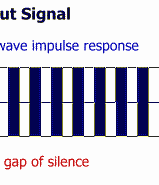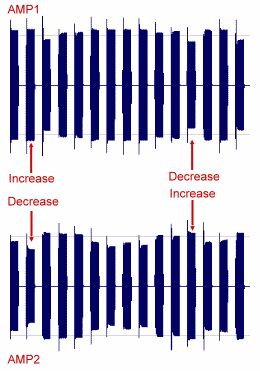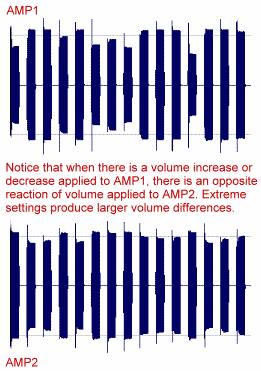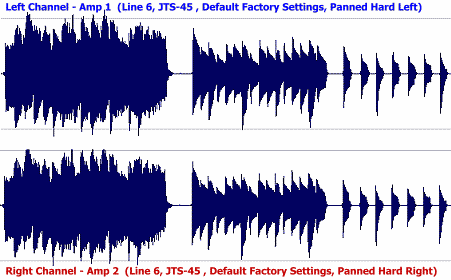|
by Nathan Shane |
||||||
|
Home Glance SYSEX Utility Photos LCD Menus Patches FX Loop Vetta MP3's FAQ Links Forum |
||||||
|
|
|
|||||
|
The Double Tracker Examined |
||||||
|
I have been surprised at how disappointed some are about the Vetta's Double Tracker. Some claim that they cannot hear the effect, or that the effect does not work right. Whether you're a novice or a pro, it has been my musical experience, that when someone claims they cannot hear a particular effect, it is simply because their musical ear has not yet developed the ability to distinguish the effect. And how could anyone say the VDT doesn't work "right" without actually knowing how Line 6 engineers define "right" according to the intended design. Therefore, it would be unfair to harshly criticize Line 6 or the Vetta for an effect that one doesn't fully comprehend. |
||||||
|
Now I'll be the first to admit, having already understood the recording production technique of double tracking, what I had envisioned in my head was going to be this miraculous, 100% accurate simulation, just like it sounds on a CD effect...but it wasn't. But then again, I realized my expectation was un-realistic, because no one else has attempted to simulate this effect to this degree in an amp before. So technically, there was really nothing to compare it to other than some "ideal" I had floating in my head about how I thought it was supposed to sound, especially in comparison to real double tracked guitars. |
||||||
|
I suppose I was really expecting the VDT to make a SUPER HUGE difference in the sound, or make one of the modeled amps sound "exactly" like a separate guitar player was playing (doubling) a track alongside my playing. After experimenting with the VDT, and thinking realistically about it...double tracking is a big call to try and reproduce with DSP (digital signal processing) technology. The sheer fact that the Vetta comes as close as it does to simulating double tracking is extremely impressive. And now that I've worked more with it, I'm so glad the effect was included. The Double Tracker is another digital tool in the toolbox that can be used...or not used...but at least it's an additional tool of choice. |
||||||
|
"the Double Tracker is another digital tool in the toolbox" |
||||||
|
For those who may not already know, "double tracking" is a popular studio technique which has been used extensively in most styles of music in order to create a thicker and more interesting guitar sound and image in the final mix. This is the process of recording a guitar track, then having the guitarist record to a second track while listening to the first and duplicating it. When the two tracks are played back together, the result is a slight "chorusing" and fattening of the signal due to minor pitch, timing, and dynamic (volume) differences between the two performances. In addition, double tracking helps to create a "stereo" guitar sound when those individual tracks are panned to different positions within the stereo field. And the Vetta works much in the same way. By allowing you to separately adjust the panning position for both AMP1and AMP2 anywhere in the stereo-field, from hard-left to hard-right, and applying the Double Tracker, you can actually create a stereo image that sounds like two separate guitar tracks. |
||||||
|
How can you accurately simulate a second guitar player or part? |
||||||
|
The reason double tracking works as well as it does in multitrack recording, is because of the inherent differences that occur when playing the same guitar part multiple times. I'm not referring to melodic differences, but the subtle performance differences of: timing, dynamics, and pitch. In the real world, there is just no way to play the same guitar part twice and have both parts be absolutely identical. So Line 6 obviously faced a tremendous challenge when they decided to include a double tracking effect. But how does one go about trying simulate a second guitar player/part in real time? Answer...with proprietary digital technology...the Vetta Double Tracker. |
||||||
|
Obviously, it is extremely challenging to manipulate an incoming guitar signal, digitally apply aspects of the "human factor" and mirror what occurs in the real world during a guitar players performance. You can easily split the incoming guitar signal into separate paths, but these are still identical clones. Even if you send these cloned signals to separate amp models, such as the Vetta does, and apply different effects and equalization, you will still be missing the three most fundamental differences: timing, dynamics, and pitch. Without these three, tonal differences alone are still not enough to produce a signal that really simulates studio double tracking. |
||||||
|
Let's take a deeper look into the "major" differences that occur. |
||||||
|
TIMING DIFFERENCES: First, there is no way to play perfectly in sync with another guitar player or pre-recorded guitar track. When jumping from chord to chord, or note to note, there will always be subtle timing differences (in the milliseconds) occurring that differ each performance. The sloppier your timing is, the more dissimilar the two guitar parts tend to sound from one another. |
||||||
|
DYNAMIC DIFFERENCES: Second, there is no way to identically match the picking and strumming dynamics of a guitar performance. There will always be times when you strum chords or play notes with varying degrees of intensity. All those subtle little volume differences add up to distinguish both parts. Also consider, that different amps, pickups, and strings, all react differently and will impose their dynamic effect upon the signal as well. |
||||||
|
PITCH DIFFERENCES: And thirdly, there is no way to have absolute identical pitch occurring at all times. There will always be micro-differences of pitch occurring between each performance. Differences of pressure applied against the fretboard, intonation differences between guitar necks, and differences in string tuning all play their part in creating pitch differences. |
||||||
|
|
||||||
|
TESTING PROCEDURE: For all you tech-heads out there, here's a detailed explanation of how the testing took place. In order to more accurately determine what kind of signal processing the VDT applies, I thought it best to start with a known constant. In this case, the known constant was the input test signal, which was created in Sound Forge to be a "mono" square wave impulse response, with a set amplitude (volume), a set impulse length (250ms), and a set duration of silence (250ms) between each impulse. What this gives you, is an easy to see waveform that looks similar to bar graph (see illustration below). If the VDT processes both AMP1 and AMP2, then we should be able to easily see any changes to our test signal. |
||||||
|
|

|
|||||
|
|
||||||
|
|
||||||
|
OBSERVATIONS: Keeping all the above background theory of timing, dynamics, and pitch in mind, let's take a look at the VDT's effect upon our test signal. We can draw some tremendous insights about what is taking place. First, the VDT apparently uses some form of input threshold sensing, because it appears to react to the incoming signal dependent upon how it sees that incoming signal. Which amp models you choose, and how you play your guitar will affect the VDT differently. In other words, if you play palm-mutes, or very staccato, or in a manner that has very distinguishable start and stop times, the VDT appears to look for those small dynamic gaps of near silence and/or intensity between chords/notes as a trigger mechanism. Long, fluid, non-dynamic, sustained signals, especially when using the naturally compressed higher distortion amp models, present fewer instances for the triggering mechanism, thereby requiring higher parameter settings in order for the double tracking effect to be more dramatic.
|
||||||
|
VDT TIMING PARAMETER: The four images below show a close up look of how the VDT's Timing Parameter affects each impulse of our incoming test signal by applying a randomly changing offset delay to either AMP1 or AMP2. There appears to be a wide window of offset delay times. And the Timing Parameter adjusts just how wide this window will be. At lower settings, the offset delays tend to be between 1ms. and 5ms. As you increase this parameter, the offset delays can vary anywhere between 1ms. up to 22ms. and more. I did not try to discover what the maximum offset delay might be, but as the owner's manual describes, it's enough to make you think you're playing with a drunk guitarist. |
||||||
|
|
|||||
|
|
|
|||||
|
|
|
|||||
|
|
||||||
|
|
||||||
|
VDT DYNAMIC PARAMETER: The two images below show a close up look of how the VDT's Dynamic Parameter affects each impulse of our incoming test signal by applying a dynamically fluctuating (semi-polarized?) volume offset to both AMP1 and AMP2. In more simple terms, it appears that as the VDT applies a volume increase (or decrease) to AMP1, there is an opposing volume change occurring in AMP2. As you increase this parameter, the volume differences can become noticeably greater to the point of sounding very unbalanced and unnatural. |
||||||
|
|
|
|||||
|
Let me show you another example. The first image below shows the left and right output signal of the Vetta with the Double Tracker turned OFF. Take notice of how the waveforms appear the same. Even though we have each amp panned hard left and right, because the output signals are virtually-identical, the sound is MONO, and appears at the very CENTER of the stereo field. |
||||||
|
|
||||||
|
The additional image below shows how the Double Tracker's Dynamic Parameter can affect an incoming guitar signal when turned up to extreme settings. Once again, take notice of how the VDT applies opposite volume adjustments to both AMP1 and AMP2. As the red lines indicate, as AMP1 is processed with a volume increase across time, AMP2 experiences a volume decease. Extreme settings produce very unnatural and unpleasant volume shifts between the two amp models. |
||||||
|
|
||||||
|
|
||||||
|
Vetta Double Tracker MP3's |
||||||
|
|
||||||
|
PARAMETER SETTINGS: The parameter settings for the Double Tracker can really vary depending upon which amp(s) you decide to use. You can sonically abuse your output signal by using more extreme settings, so try very minimum settings when first tweaking the parameters. Using two different amp models will help to produce more realistic results for stereo recording. And your style of playing has a direct affect upon how the VDT works. |
||||||
|
|
||||||
|
The following MP3's use the factory settings. AMP1 and AMP2 were the same. |
||||||
|
The TIMING parameter seems to be the most sonically useful. Just one TIMING knob "click" past OFF is enough to make a noticeable difference, by subtlety widening the two amps into a stereo image. At higher settings, the timing differences increase, and produce an even more distinct stereo image. TIMING settings up to 12 o'clock work best, and you may find some use for settings above this, but set too high, and you may find too much "sloppiness" between the two amps. You may also notice that when using "identical" amp models and settings panned hard left and right, the timing differences that occur between AMP1 and AMP2 cause the signal to jump around in the stereo field. But keep in mind, this is typically not the sonic result when two different amp models are used, and it may be best to actually use two different amp models to achieve full potential.
|
||||||
|
|
||||||
|
The PITCH parameter simply adds a subtle detuning between the two amp models. Minimum settings can go unnoticed. The detuning really becomes apparent only at higher settings. |
||||||
| The DYNAMIC parameter is the one most difficult to adjust. Minimum settings up to 9 o'clock seem to work best and sound more natural. However, if you adjust the setting too high, you will get very unnatural increases and decreases of volume between the two amps. | ||||||
|
FINAL CONCLUSIONS: The Double Tracker is more easy to recognize while listening to a playback recording of the Vetta then when you are in the midst of playing the guitar (with the exception of using an extension cab). When you are sitting in the "sweet" spot between studio monitors (or between the Vetta Combo and a Vetta 212S Extension Cab), the effect is clearly heard, and impressive enough to appreciate when you get the parameter settings adjusted properly. Anyone with a good ear and attention to sonic detail will definitely notice it immediately. But realistically, how many end users are sitting in front of studio monitors playing the Vetta direct (with the amps speakers turned off). Some users may actually be hearing the effects of the VDT, but not recognize the effect depending upon their degree/level of experience working with stereo signals...and so many guitar amps are mono (with stereo fx), so many users may be less experienced with the stereo capabilities of having two configurable amp models. |
||||||
|
I'll be the first to say that the Double Tracker may not be distinctly recognized if you are playing "only" through the Vetta Combo's speakers, this is simply due to the fact that the amps speakers are located so close to each other, and the listener is surrounded with sound. However, the effect becomes much more distinct when recording from the DIRECT OUTPUTS while listening to playback on studio monitors...you are able to point to an exact location in the stereo-field from where the sound of each amp originates, and hear the timing, dynamic, and pitch differences.
And the DT can sound downright awesome when using the Vetta 212S Extension Cab (or any additional extension cab) to actually create some physical space between the amp models when they are panned hard left and right. Having an additional Extension Cab is the "only" and best way to compliment the Vetta Combo so you can hear the full potential of sound that it is capable of producing. An Extension Cab provides for a very wide "stereo" separation of the amp models, because the Vetta Combo is handling the LEFT side of the stereo outputs, and the Ext.Cab is handling the RIGHT. |
||||||
|
With the right settings, the Double Tracker can be used most effectively with both direct recording and live performance. The VDT can produce some fantastic stereo results provided you have the parameters adjusted to optimize the effect for whichever amp model(s) you decide to use. Used in the home recording studio, it can really sound very similar to a double tracked guitar. Used on stage, it can add a "wide" 3-dimensional quality to the sound...especially if you are using the PING PONG DELAY which will jump between the cabs LEFT-RIGHT-LEFT-RIGHT etc. Can it accurately re-create a double tracked guitar 100%...almost. The technology is there and can only get better over time. Line 6 has created a winner effect in my book, and I look forward to the day when their digital technology reaches the point of completely fooling out sonic senses. - NS |
||||||
|
Home Glance SYSEX Utility Photos LCD Menus Patches FX Loop Vetta MP3's FAQ Links Forum |
||||||








